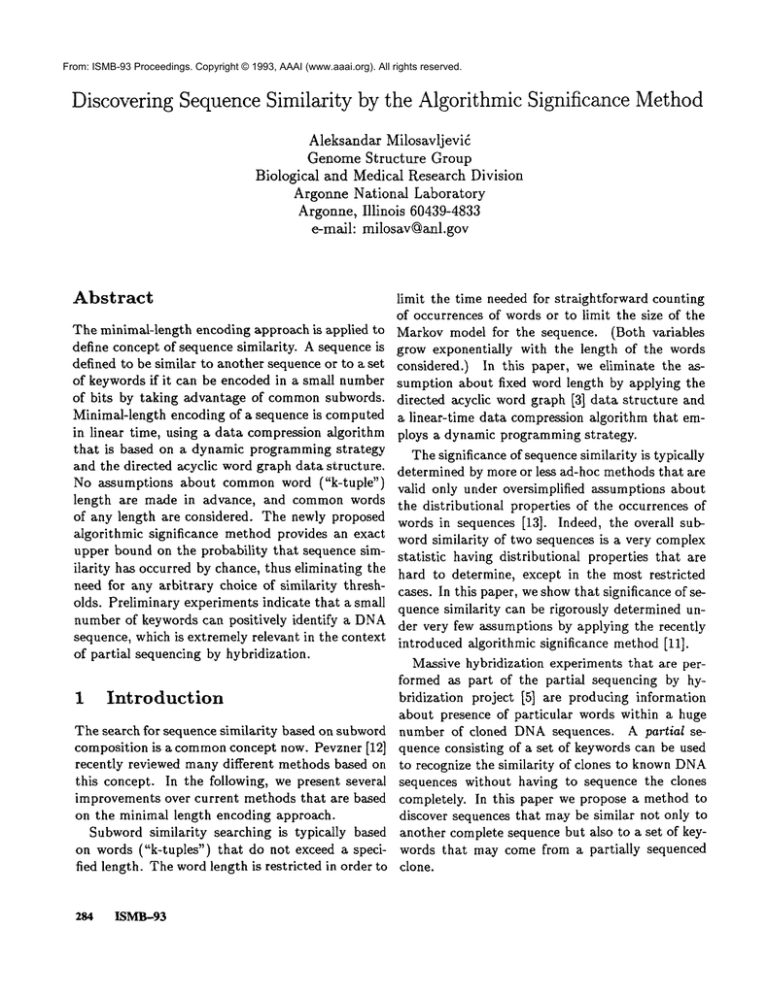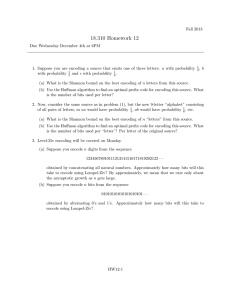
From: ISMB-93 Proceedings. Copyright © 1993, AAAI (www.aaai.org). All rights reserved.
DiscoveringSequenceSimilarity by the AlgorithmicSignificance Method
Aleksandar Milosavljevid
Genome Structure
Group
Biological and Medical Research Division
Argonne National Laboratory
Argonne, Illinois 60439-4833
e-mail: milosav@anl.gov
Abstract
limit the time needed for straightforward counting
of occurrences of words or to limit the size of the
The minimal-length encoding approach is applied to Markov model for the sequence. (Both variables
define concept of sequence similarity. A sequence is grow exponentially with the length of the words
defined to be similar to another sequence or to a set considered.) In this paper, we eliminate the asof keywords if it can be encoded in a small number sumption about fixed word length by applying the
of bits by taking advantage of commonsubwords. directed acyclic word graph [3] data structure and
Minimal-length encoding of a sequence is computed a linear-time data compression algorithm that emin linear time, using a data compression algorithm ploys a dynamic programming strategy.
that is based on a dynamic programming strategy
The significance of sequence similarity is typically
and the directed acyclic word graph data structure.
determined by more or less ad-hoc methods that are
No assumptions about common word ("k-tuple")
valid only under oversimplified assumptions about
length are made in advance, and common words the distributional properties of the occurrences of
of any length are considered. The newly proposed words in sequences [13]. Indeed, the overall subalgorithmic significance method provides an exact word similarity of two sequences is a very complex
upper bound on the probability that sequence sim- statistic having distributional properties that are
ilarity has occurred by chance, thus eliminating the hard to determine, except in the most restricted
need for any arbitrary choice of similarity thresh- cases. In this paper, weshowthat significance of seolds. Preliminary experiments indicate that a small quence similarity can be rigorously determined unnumber of keywords can positively identify a DNA der very few assumptions by applying the recently
sequence, which is extremely relevant in the context introduced algorithmic significance method [11].
of partial sequencing by hybridization.
Massive hybridization experiments that are performed as part of the partial sequencing by hybridization project [5] are producing information
1 Introduction
about presence of particular words within a huge
The search for sequence similarity based on subword number of cloned DNAsequences. A partial secomposition is a commonconcept now. Pevzner [12] quence consisting of a set of keywords can be used
recently reviewed many different methods based on to recognize the similarity of clones to knownDNA
this concept. In the following, we present several sequences without having to sequence the clones
improvements over current methods that are based completely. In this paper we propose a method to
on the minimal length encoding approach.
discover sequences that may be similar not only to
Subwordsimilarity searching is typically based another complete sequence but also to a set of keyon words ("k-tuples") that do not exceed a speci- words that may come from a partially sequenced
fied length. The word length is restricted in order to clone.
284
ISMB-93
2
Minimal Encoding
Similarity
Length
and
The main idea behind the approach presented in
this paper is that similarity canbe defined via minimal encoding length. We ask whether or not a
particular sequence which we call the target can be
concisely encoded using another sequence or a set
of keywords, which we call the source. If there is no
similarity, then the knowledge of the source does
not help, but if we succeed in using the source to
find an encoding of the target sequence that is much
shorter than is likely by chance, then we can prove
at a high significance level that the source and the
target are related. For a broader introduction to
minimal length encoding see [4].
A target sequence is defined to be similar to a
source sequence if it can be encoded concisely by
replacing some words in it by pointers to the occurrences of the same words in the source. This
is a standard technique in data compression [14].
Consider an example where the target sequence is
GATTACCGATGAGCTAAT
and the source sequence is
ATTACATGAGCATAAT
The occurrences of some words in the target may be
replaced by pointers indicating the beginning and
the length of the occurrences of the same words in
the source. In the following, a pointer is denoted
by a pair of integers in parentheses, the first indicating the position of occurrence in the source and
the second the length of the commonword. For
example,
G(1,4)CCG(6,6)(13,4)
One can think of the encoded sequence as being
parsed into words that are replaced by pointers and
into the letters that do not belong to such words.
One may then represent the encoding of a sequence
by inserting dashes to indicate the parsing. For the
encoding above, the parsing is indicated as follows:
G-ATTA-C-C-G-ATGAGC-TAAT
Let us now count the exact number of bits needed
to encode letters
and pointers. We may assume
that the encoding of a sequence consists of units,
each of which corresponds either to a letter or to a
pointer. Every unit contains a (log 5)-bit field that
either indicates a letter or announces a pointer. A
unit representing a pointer contains two additional
fields with positive integers indicating the position
and length of a word. These two integers do not
exceed n, the length of the source sequence. Thus,
a unit can be encodedin log 5 bits in case of a letter
or in log 5 -t- 2 log n bits in case of a pointer.
If it takes more bits to encode a pointer then
to encode the word letter by letter, then it does
not pay off to use the pointer. Thus, the encoding
length of a pointer determines the minimumlength
of commonwords replaced by pointers. In order to
take advantage of shorter commonwords, we must
encode the pointers more concisely.
The pointers can be encoded more concisely under two plausible assumptions. The first assumption is that the commonwords occur in similar order in the target as in the source, in which case
the position of the commonword in the source can
be indicated relative to the previous commonword;
this relative distance mayfall into a smaller range
than the absolute position and thus it maybe represented in fewer bits. The second assumption is that
the lengths of the commonwords fall into a smaller
range. Under these two assumptions, one may encode a pointer in muchless than log 5-)-2 log n bits.
If a word to be replaced by a pointer occurs more
than once in the source, then the information about
the particular occurrence contained in the pointer
maybe more than is necessary. If the pointer could
specify only the set of occurrences and not any particular occurrence, then the pointer itself wouldrequire fewer bits. Wewill comeback to the problem
of pointer size later in the experimental section.
Consider the case of a target sequence that is encoded using a set of keywords as the source. A
sequence is in this case encoded using a pointer
that consists of three numbers: an index of the keyword and the beginning and the end of the subword
within the keyword.
Consider the following target sequence:
GATTACCGATGAGCTAAT
and the source keywords:
I AAAAGGGGGG
Theorem 1 For any distribution
of probabilities
Po over sequences and for any decoding algorithm
A,
P{- log po (t) - IA (t) >_ d} -d
2 ATTACATG
3 AGCATAAT
4 ATGAGCATA
where po(t) is the probability assigned to sequence
t by distribution Po and In(t) is the length of
encoding of sequence t using algorithm A.
The following is an encoding of the target sequence Proof of Theorem1 can be found in [11]. (Similar
relative to the source keywords:
theorems are proven in the context of competitive
encoding [4].)
This theorem enables us to use algorithm A as an
G(2,1,4)CCG(4,1,6)(3,5,4)
alternative hypothesis to refute the null hypothesis
It is easy to see from these two examples that one P0 at the significance level 2-d. Applying the incan construct a decoding algorithm that within it equality above to our example, the probability that
contains a source sequence or source keywords and a target sequence t will have an encoding d = 7
that reconstructs the target sequence from its en- bits less than - log po(t) = - ~: n~: log p=(t) is less
than 2-7 , which is less than the standard significoding.
cance threshold of 0.01.
The exponential relationship between encoding
Significance
3 Algorithmic
length and probability allows us to establish significance even whenvery large sequence libraries are
Method
searched. If the sequence library searched contains
Let A denote a decoding algorithm that can recon- sequences of total length L, then to refute the null
struct the target sequence. Wemay assume that the hypothesis at the significance level of 0.01 for any
source (sequence or set of keywords) is part of the sequence in the library, d = 7 + log L bits would
algorithm A so that only the encoded target needs suffice (but maynot be necessary).
to be supplied. Weexpect that the targets that are
The algorithmic significance method is conceptusimilar to the source will have short encodings. By ally very similar to the concept of statistical signifIA(t) we denote the length of the encoded target t. icance in the Neyman-Pearson hypothesis testing
Let P0 denote the null hypothesis, i.e., the distri- framework (see, e.g., [9]). The main difference
bution of probabilities under the assumption that that the alternative hypothesis is nowrepresented
the target isequence is independent from the source. by a decoding algorithm instead by an explicit distribution of probabilities.
Let po(t) be the probability assigned to a target
by the null hypothesis. For example, if we assume
In contrast to the concept of statistical signifithat every letter is generated independently with cance that is based on the approximate (asympprobability px, where z E {A, G, C, T} denotes the totic) estimation of tails of distributions ("p-value’)
letter, then the probability of a target sequence t of statistics like length of the longest commonword
is po(t) = I-I~p~ ~(t), where n~(t) is the number of or number of commonwords (see, e.g., [8]), the
occurrences of letter x in t. If we assume a Markov algorithmic significance method provides an exact
dependency, then the probability of a sequence can significance value. Moreover, algorithmic signifiefficiently be computed for the given Markovmodel. cance is directly applicable for any null hypotheThe following theorem states that a target se- sis for which po(t) can be computed, as opposed
quence t is unlikely to have an encoding much the statistical significance value whichis applicable
only for a specific distribution.
shorter than - log po(t).
286 ISMB-93
4
Minimal
gorithm
Length
Encoding
Al-
the Human Tissue Plasminogen Activator (TPA)
gene [6]. Three kinds of sources were used: the
complete Alu consensus sequence [7] and keyword
Short encodings are not only significant, but they sets consisting of eight and four 8-mers chosen to
can also be computedefficiently. In this section we be evenly distributed along the consensus.
present a minimal length encoding algorithm, which
The complete TPA gene, GenBank [2] accesis a slight variant of the algorithm for discovering sion number K03021, containing 36,594 bases was
simple sequences [11] and which is frequently used searched. The sequence was considered one window
in data compression [14].
at a time, with windowsof length 350 and an overThe algorithm takes as an input a target sequence lap between adjacent windows of 175. The value
t and the encoding length p > 1 of a pointer and of log p0(t) was. computed under the assumption
computes a minimal length encoding of t for a given that letters are generated independently by a unisource s (here s denotes either a source sequence or form distribution. An encoding length threshold of
keywords). Since it is only the ratio between the 22 > 7+log 36594 bits was chosen so that the probpointer length and the encoding length of a letter
ability of any windowhaving short encoding would
that matters, we assume, without loss of generality, be guaranteed not to exceed the value of 0.01.
that the encoding length of a letter is 1.
The only difference in program input between the
Let n be the length of sequence t and let tk denote
three experiments (except, of course, the source itthe (n - k + 1)-letter suffix of t that starts in the
self) was the pointer size. Whenthe source was the
kth position. Using a suffix notation, we can write
complete Alu consensus sequence, a pointer length
tl instead of t. By I(tk) we denote the minimal
of 8 bits was chosen under the assumption that the
encoding length of the suffix tk. Finally, let l(i),
distance between consecutive commonwords and
where 1 < i < n, denote the length of the longest
common word length can each be encoded using
word that starts at the i th position in target t and
4 bits on average. In the case of keyword sets,
that also occurs in the source s. If the letter at
the pointer size was chosen as the binary logarithm
position i does not occur in the source, then l(i)
of the number of keywords plus 2 bits to locate a
0. Using this notation, we may now state the main
subword within a keyword. One may argue that
recurrence:
more bits would be required to locate a subword;
our choice of fewer bits can be justified by the fact
I(t~) = rain(1 + I(ti+l),p+ /(ti+z(O))
that only the subwords that exceed a certain length
Proof of this recurrence can be found in [14].
need to be located, and also that short subwords
Based on this recurrence, the minimal encoding are likely to have multiple occurrences, so that a
length can now be computed in linear time by the pointer to any particular occurrence would contain
following two-step algorithm. In the first step, the excess information.
values l(i), 1 < i < ar e computed inlin ear tim e
The windowsthat could be encoded in 22 bits less
by using a directed acyclic word graph data struc- than postulated by the null hypothesis were merged
ture that contains the source s [3]. In the second to obtain a set of non-overlapping regions. Table 1
step, the minimal encoding length I(t) = I(tl) is contains a comparison of occurrences of Alu and
computedin linear time in a right-to left pass using half-Alu sequences in the TPAgene in direct orienthe recurrence above.
tation with the regions identified as Alu-like. There
were no false positive matches.
5
Implementation
ments
and Experi-
Figure 1 contains an example of a windowparsed
using a complete Alu consensus sequence as a
source, together with an alignment of the Alu conThe algorithm above was implemented in C+q- on sensus with a segment within the window. Figure 2
a Sun Sparcstation under UNIX. The program was contains the eight- and four-keyword sets used and
applied to identify occurrences of Alu sequences in a windowparsed using the four-keyword set.
Mllosavljevic 287
Parsed window 22226-22575 from the TPA gene:
C-T-CAGTG-C-C-T-G-TCAAAA-G-T-A-T-G-T-GCTGAGGC-T-G-G-A-A-G-GTGGTG-C-A-T
-GCCTGT-G-ATCCCAGCACTTT-A-GGAGGCC-A-A-G-G-TGGGAGG-G-TCGCT-G-G-A-G-CCCG
GGAG-T-T-C-A-AGACCA-A-T-CTGGGC-A-AACAT-A-G-C-A-A-G-T-C-C-C-C-T-GTCTCTA
C-A-AAAAATA-A-AAAAATTAGCC-AGACC-T-G-G-T-A-T-G-T-A-G-TCCCA-A-C-T-A-C-TT
GGGAGG-T-TGAGGCAG-A-A-GGATCAC-T-TGAGCC-CAGGAGTT-GGAGGCTG-C-A-GTAATC-TA-C-G-A-T-T-A-T-GCCACTGCA-T-T-T-C-A-A-C-C-T-CAGTGA-C-A-G-G-G-C-A-A-G-C
-C-C-TCACCT-CTAAAA-C-A-A-A-ACAAAA-CAACA-C-A-A-ACAAAAA-CAAAAA-C-ACAGA-A
-A-A-G-C-C-C
Ali~rnment (Alu consensus is on top and a fragment from the parsed window
is on the bottom):
@10
@20
@30
@40
@50
@60
@70
GGCCGGGCGCGGTGGCTCACGCCTGTAATCCCAGCACTTTGGGAGGCCGAGGCGGGCGGATCACCTGAGG
GGCTGG--AAGGTGGTGCATGCCTGTGATCCCAGCACTTTAGGAGGCCAAGGTGGGAGGGTCGCTGGAGC
@30
@40
@50
@60
¢70
@80
@90
@80
@90
@110
@I00
@120
@130
TCAGGAGTTCGAGACCAGCCT-GGCCAACATGGTGAAACCCC-GTCTCTACTAAAAATACAAAAATTAGC
CCGGGAGTTCAAGACCAATCTGGGCAAACATAGCAAGTCCCCTGTCTCTACAAAAAATAAAAAAATTAGC
@100
@110
@120
@160
@130
@140
@150
@140
@150
@160
@170
@200
@180
@190
CGGGCGTGGTGGCGCGCGCCTGTAATCCCAGCTACTCGGGAGGCTGAGGCAGGAGAATCGCTTGAACCCG
CAGACCTGGTA .........TGTAGTCCCAACTACTTGGGAGGTTGAGGCAGAAGGATCACTTGAGCCCA
@170
@180
@190
@200
@210
@230
@210
@220
~240
~250
@260
@270
GGAGGCGGAGGTTGCAGTGAGCCGAGATCGCGCCACTGCACTCCAGCCTGGGCGACAGAGCGAGACTCCG
GGAGTTGGAGGCTGCAGTAATCTACGATTATGCCACTGCATTTCAACCTCAGTGACAGGGCAAGCCCTCA
@220
@230
@240
@250
@260
@270
@280
@280
TCTCAAAAAAAA
CCTCTAAAACAA
@290
Figure
288
ISMB-93
1: Parsing
of window 22226-
22575 from the
TPA gene.
Aiu occurrence
I Alu consensus
740...1033
526...1225
8864...9176
8576...9275
10067...10365
9801...10500
16794...17125, 17170...17466 16626...17675
18879...19178
18726...19425
20826...21700
20946...21259,21280...21578
22253...22545
22051...22750
25376...26075
25620...25911
26251...27475
26524...26821,26941...27239
27880,.28145
27651...28350
28526...29575
28804...29100,29297...29431
32726...33425
32921...33220
33951...34650
34234...34525
identified Alu regions
Eight 8-mers
526...1225
875i...9275
9976....10500
16976...17500
18726...19250
20826...21700
22226...22575
25551...25900
26426...26926,26927...27475
27826...28350
28701...29575
32726...33425
34126...34650
Four 8-mers
701...1050
16976...17325
18901...19250
21176...21700
26426...26775
32901...33250
Table 1: Occurrences of Alu sequences in the TPA gene and the identified
Alu regions. Some
rows correspond to pairs of Alu sequences that occur close together.
There were no false
positive matches.
A1u keywordsets used in search:
Eight 8-mers: 1GGCCGGGC
2 AGCACTTT
3 CTGAGGTC
4 ACATGGTG
5
6
7
8
AAAAATTA
TAATCCCA
GAATCGCT
GTGAGCCG
Four 8-mers: 1GGCCGGGC
2 CTGAGGTC
3 AAAAATTA
4 GAATCGCT
Window 18901-19250from the TPA gene parsed using the set of four
8-mers as a source:
T-G-T-AATC-T-C-A-G-C-A-C-T-T-T-GGG-A-GGCCG-AGGT-G-G-GAGG-ATCGCT-TGAG-C
-C-C-AGG-A-G-T-T-G-GAG-A-C-C-A-GTC-T-GGGC-ART-A-T-A-G-TGAG-A-T-GCT-GTC
-T-C-T-A-C-A-AAAAATT-T-AAAAATTA-GCCGGG-T-G-T-A-C-T-A-G-T-A-T-G-C-A-C-C
TG-T-GGTC-C-C-A-GCT-A-C-T-C-A-G-GAGG-CTGAGG-CGGG-AGG-ATCGCT-T-A-A-G-TT-C-A-G-GAGGT-T-GGG-A-C-T-T-C-A-G-TGAG-A-T-A-T-G-ATTA-CGC-C-AAT-G-C-AC-T-C-C-A-GCC-T-GGG-TGA-C-AAA-CTGAG-ATC-CTG-T-C-T-C-AAAAA-AAAAA-AAAAAAAAA-G-AAAAA-GGC-AAT-G-C-A-A-G-T-GCC-A-TGAG-C-C-A-C-A-G-C-A-GAGG-C-AAA
-CTG-C-C-C-T-C-A-T-GGT-GCC-T-A-C-T-C-T-C-T-A-G-CTGA
Figure 2:Alu keyword sets
l~t off our keywords.
used in the search
and an example of a window parsed
using the
Milosavljevi6 289
6
Discussion
domains like DNAsequence analysis, in contrast
to the more standard statistical
approaches which
The experiments indicate that a surprisingly small have mostly been motivated by real-valued meanumber of keywords suffice to identify Alu se- surements. Instead of focusing on a particular paquences. The exact number of necessary keywords rameter (e.g., length of the longest repeated word),
may depend on the degree of similarity between se- the algorithmic significance approach enables us to
quences of a particular class, but it seems that 10 focus on the information content (as measured by
or less 8-mers wouldsuffice to identify a similarity the encoding length), which is a muchmore widely
of 80% in sequences about 300 long. This means applicable parameter.
that the sequence similarity of many cloned DNA
sequences to known sequences may be determined
7 Acknowledgements
without the exact knowledge of their complete sequence; a partial sequence consisting of a set of key- Discussions with Radoje Drmanac, Ivan Labat,
words that have been identified in the clone may Radomir Crkvenjakov, Jerzy Jurka, and Thomas
suffice [10] [5].
Cover have greatly contributed to this work.
The method described in this paper has also been
This work was supported in part by U.S. Departsuccesfully used for rapid screening for sequence ment of Energy, Office of Health and Environmensimilarity by the Pythia email server for identifital Research, under Contract W-31-109-Eng-38and
cation of Humanrepetitive DNA(for more inforin part by U.S. Department of Energy grant DEmation about Pythia, send "help" in Subject-line
FG03-91ER61152.
to Internet address pythia~anl.gov).
Current methods typically require two arbitrary
assumptions to be made for each similarity search: References
one about the length of the longest commonword
[1]L. Allison and C.N. Yee. Minimum message
that is to be considered and the other about the
length encoding and the comparison of macrothreshold of similarity for significant matches. At
molecules. Bulletin of Mathematical Biology,
the same time, the exact significance of the match is
52:431-453, 1990.
not computed. The method proposed in this paper
removes the need for any restrictions on word length
H.S. Bilofsky and C. Burks. The GenBank(R)
while keeping the computation time linear, and it
genetic sequence data bank. Nucleic Acids Realso provides an exact bound on significance, thus
search, 16:1861-1864, 1988.
removing need for any arbitrary thresholds. ExperA. Blumer, J. Blumer, D. Haussler, A. Ehreniments indicate that this systematic approach can
feucht, M.T. Chen, and J. Seiferas. The smalleliminate false positive matches while retaining senest automaton recognizing the subwords of a
sitivity.
text. Theoretical Computer Science, 40:31-55,
The algorithmic significance method can also be
1985.
applied to discover similarity based on sequence
alignment. For this case, the target sequence may
T. Cover and J. Thomas. Elements of Inforhave to be encoded using a set of edit operations.
mation Theory. Wiley, 1991.
A minimal length encoding approach to sequence
alignment has been discussed in [1]; the coding tech[5]R. Drmanac, G. Lennon, S. Drmanac, I. Laniques presented there can be combined in conjuncbat, R. Crkvenjakov, and H. Lehrach. Partion with the algorithmic significance methodto obtiai sequencing by hybridization:
Concept
tain exact bounds on significance.
and applications in genome analysis. In In:
The First International Conference on ElecThe applications mentioned in this paper are just
trophoresis,
Supereomputing and the Human
a small sample of possible applications of the conGenome,
pages
60-74.
World Scientific, Singacept of algorithmic significance. The key feature
pore, 1991.
of the concept is its applicability in combinatorial
290 ISMB-93
[6] S.J. Friezner-Degen, B. Rajput, and E. Reich. The human tissue plasminogen activator gene. Journal of Biological Chemistry,
261:6972-6985, 1986.
[7] J. Jurk~ and A. Milosavljevi~. Reconstruction
and analysis of human Alu genes. Journal of
Molecular Evolution, 32:105-121, 1991.
[8] S. Karlin, F. Ost, and B.E. Blaisdell. Mathematical Methods for DNASequences, chapter
Patterns in DNAand Amino Acid Sequences
and their Statistical Significance. CRCPress,
Boca Raton, Florida, 1989.
[9] J.C. Kiefer. Introduction to Statistical
ence. Springer-Verlag, 1987.
Infer-
[10] G.G. Lennon and H. Lehrach. Hybridization
analyses of arrayed cDNAlibraries. Trends in
Genetics, 7(10):314-317, 1991.
[11] A. Milosavljevi~ and J. Jurka. Discovering simple DNAsequences by the algorithmic significance method. Computer Applications in Biosciences, in press.
[12] P.A. Pevzner. Satistical distance between texts
and filtration
methods in sequence comparison. Computer Applications in Biosciences,
8(2):121-127, 1992.
[13] P.A. Pevzner, M.Y. Borodovsky, and A.A.
Mironov. Linguistics of nucleotide sequences I:
The significance of deviations from mean statistical characteristics and prediction of the frequencies of occurrence of words. Journal of
Biomolecular Structure and Dynamics, 6:10131026, 1989.
[14] J.A. Storer. Data Compression: Methods and
Theory. Computer Science Press, 1988.
MHosavUevi~ 291







